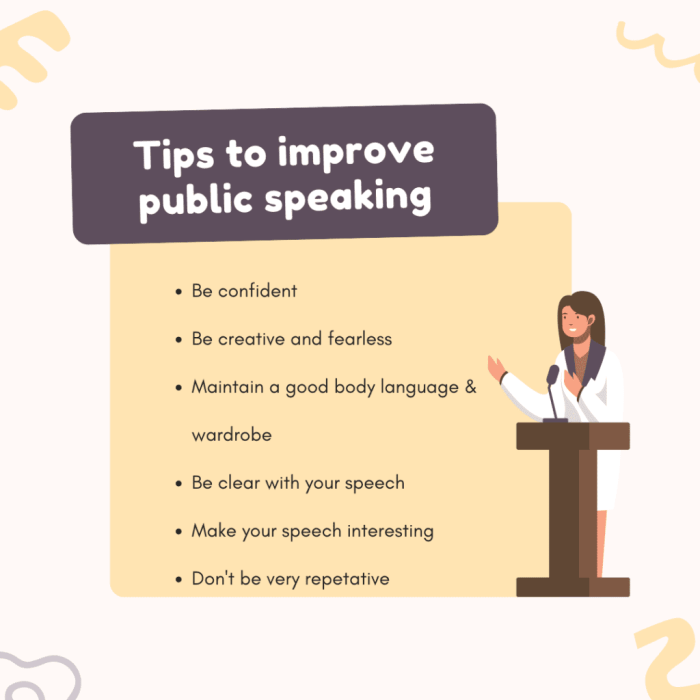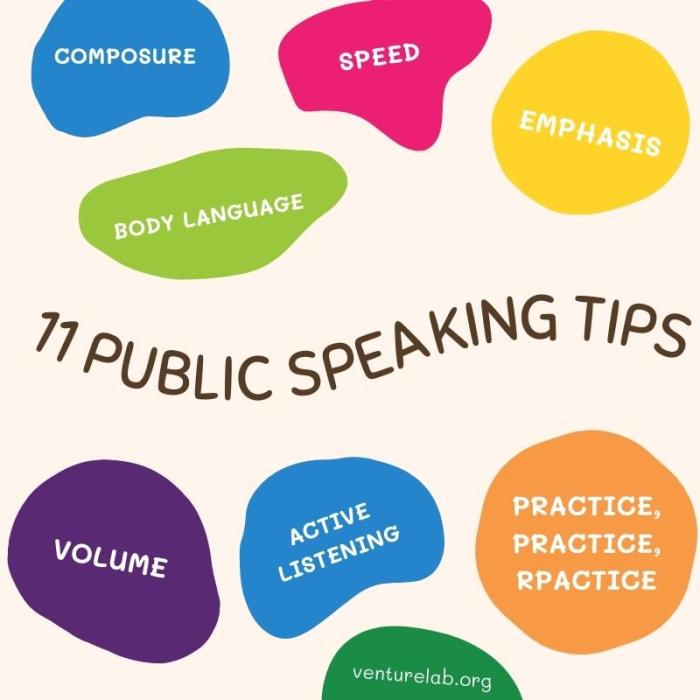Public Speaking Tips are crucial for success in various aspects of life, from presentations to job interviews. With the right skills, you can captivate any audience and leave a lasting impression. Let’s dive into the essentials of becoming a confident and effective public speaker.
Introduction to Public Speaking Tips
Public speaking is the art of communicating effectively to an audience. It plays a crucial role in various aspects of life, from academic presentations to professional meetings and even social gatherings. Mastering public speaking skills can greatly enhance one’s confidence, persuasion, and overall communication abilities.
Benefits of Mastering Public Speaking Skills
- Improved Confidence: Public speaking helps individuals overcome stage fright and boosts self-assurance.
- Enhanced Communication: Effective public speakers can convey their ideas clearly and engage their audience.
- Career Advancement: Strong public speaking skills are highly valued in the workplace and can lead to better opportunities.
- Leadership Development: Public speaking is a key component of leadership, allowing individuals to inspire and motivate others.
Examples of Situations Where Public Speaking Skills are Valuable
- Presenting a project in class
- Delivering a speech at a conference
- Negotiating a business deal
- Speaking at a social event or gathering
Overcoming Stage Fright
Stage fright is a common fear that many people experience when speaking in front of an audience. It can manifest in various symptoms such as increased heart rate, sweaty palms, shaky voice, and blanking out.
Practical Techniques to Manage and Reduce Stage Fright, Public Speaking Tips
- Breathing exercises: Take deep breaths before going on stage to calm your nerves and regulate your heartbeat.
- Visualization: Imagine yourself delivering a successful speech to boost your confidence and reduce anxiety.
- Practice relaxation techniques: Incorporate mindfulness or meditation practices into your daily routine to manage stress levels.
- Positive self-talk: Replace negative thoughts with affirmations to build a positive mindset before speaking.
How Preparation and Practice Can Help in Overcoming Stage Fright
- Rehearse your speech multiple times to familiarize yourself with the content and build confidence in your delivery.
- Prepare cue cards or notes to refer to during your speech to stay on track and minimize the fear of forgetting your lines.
- Engage in mock presentations with friends or colleagues to simulate the experience of speaking in front of an audience and receive constructive feedback.
- Familiarize yourself with the venue and equipment to reduce any unexpected surprises that may trigger anxiety on the day of your speech.
Structuring Your Speech
When it comes to giving a killer speech, the way you structure your content can make or break your delivery. A well-structured speech not only keeps your audience engaged but also helps you convey your message effectively. Here are some key components of a well-structured speech and tips on how to organize your content like a pro.
Components of a Well-Structured Speech
- Clear Introduction: Start strong with a hook to grab your audience’s attention. Clearly introduce your topic and establish why it’s important.
- Informative Body: Break down your main points logically. Use examples, statistics, and anecdotes to support your arguments.
- Compelling Conclusion: Summarize your key points and end with a memorable closing statement that reinforces your message.
Tips for Organizing Content Effectively
- Artikel Your Speech: Create a clear Artikel with bullet points to ensure a smooth flow of ideas.
- Use Transitions: Transition smoothly between different sections of your speech to maintain coherence.
- Vary Your Pace: Mix up the pace of your speech to keep your audience engaged and emphasize key points.
Importance of Introduction, Body, and Conclusion
- Introduction: Sets the tone for your speech and captures your audience’s attention from the start.
- Body: Delivers the main content of your speech and provides supporting evidence for your arguments.
- Conclusion: Wraps up your speech by reinforcing key points and leaving a lasting impression on your audience.
- Use vivid descriptions and details to make your stories come to life.
- Ensure that your stories are relevant to your main points and reinforce the message you want to convey.
- Practice delivering your stories with enthusiasm and authenticity to captivate your audience.
- Use humor to make complex or dry topics more relatable and engaging.
- Practice your comedic timing and delivery to ensure that your jokes land effectively.
- Don’t force humor – let it flow naturally and authentically within your speech.
- Engage the audience by encouraging them to share their thoughts or experiences related to the topic.
- Use props, visual aids, or multimedia to create a multi-sensory experience for the audience.
- Break up your speech with interactive elements to maintain interest and prevent boredom.
- Use gestures to emphasize key points and add energy to your speech.
- Maintain good eye contact to establish a connection with your audience and show confidence.
- Pay attention to your posture to appear confident and authoritative.
- Practice voice modulation to add emphasis and keep your audience engaged.
- Work on your pacing to ensure that your speech flows smoothly and maintains the audience’s interest.
- Use intonation to convey emotions and create a dynamic delivery.
- Prepare in advance by reviewing your speech and considering possible questions that may arise.
- Maintain eye contact with the audience member asking the question to show attentiveness.
- Take a moment to collect your thoughts before responding to ensure clarity and precision in your answer.
- Acknowledge the question and repeat or rephrase it if necessary to ensure understanding.
- Be honest if you don’t know the answer and offer to follow up with more information later.
- Focus on the speaker without interrupting and avoid formulating your response before they finish speaking.
- Ask for clarification if needed to ensure you address the actual question being posed.
- Show empathy and understanding towards the questioner to foster a positive interaction.
- Consider the main points of your speech and anticipate questions that may arise based on those topics.
- Reflect on the audience’s perspective and think about what they might be curious or concerned about.
- Practice answering a variety of potential questions to build confidence and familiarity with different scenarios.
- Consider the type of speech you are giving and the message you want to convey. Different visual aids such as slides, videos, or props may be more suitable for different types of speeches.
- Ensure that the visual aids are relevant and add value to your presentation. Avoid using unnecessary or distracting visuals that do not contribute to the overall message.
- Choose visuals that are clear, easy to read, and visually appealing. Make sure they support your points rather than overshadowing them.
- When using slides, keep them simple and concise. Use bullet points, images, and graphs to highlight key information without overcrowding the slides with text.
- Videos can be a powerful tool to engage the audience and bring your message to life. Make sure the videos are high-quality, relevant, and properly integrated into your speech.
- Props can add a tactile element to your presentation and make complex ideas more accessible. Choose props that are easy to handle and relevant to the topic you are discussing.
Engaging the Audience

To capture the audience’s attention from the beginning, start with a powerful opening that relates to your topic. This could be a shocking statistic, a thought-provoking question, or a compelling story.
Using Storytelling
Storytelling is a great way to maintain audience engagement throughout your speech. By weaving personal anecdotes or relevant stories into your presentation, you can connect with the audience on an emotional level. This helps to keep them interested and invested in what you have to say.
Incorporating Humor
Humor is another effective tool for engaging the audience. A well-placed joke or funny anecdote can lighten the mood, break the ice, and make your speech more memorable. However, be mindful of your audience and avoid offensive or inappropriate humor.
Interactive Elements
Incorporating interactive elements into your speech can also help keep the audience engaged. This could include asking thought-provoking questions, conducting polls or surveys, or inviting audience participation through activities or demonstrations.
Body Language and Vocal Delivery: Public Speaking Tips
Body language and vocal delivery play a crucial role in public speaking, as they can enhance the message you are trying to convey and help you connect with your audience on a deeper level.
Using Body Language Effectively
Vocal Delivery Tips
Handling Q&A Sessions

When it comes to handling Q&A sessions, it’s essential to exude confidence and respond effectively to questions from the audience. Anticipating potential questions and actively listening are key components of a successful Q&A session.
Techniques for Confidently Responding
Importance of Active Listening
Active listening is crucial during Q&A sessions as it demonstrates respect for the audience and helps you fully comprehend the question being asked.
Preparing for Potential Questions
Visual Aids and Presentation Tools
Visual aids play a crucial role in enhancing a presentation by making information more engaging and easier to understand for the audience. They can help reinforce key points, provide visual context, and create a more memorable experience for the listeners.






